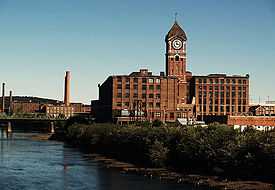American Woolen Company
The American Woolen Company was established in 1899 under the leadership of William M. Wood and his father-in-law Frederick Ayer through the consolidation of eight financially troubled New England woolen mills. At the company's height in the 1920s, it owned and operated 60 woolen mills across New England. It is most known for its role in the Lawrence textile strike of 1912.
History

The American Woolen Company was the product of the era of trusts. Overproduction, competition and poor management had brought the New England textile industry to its knees by the 1890s. In particular, family trusts, the main shareholders of many of the mills, insisted on receiving high dividends instead of making necessary capital improvements. Frederick Ayer, successful Lowell merchant, purchased the Washington Mills in Lawrence, Massachusetts and hired his son-in-law, William M. Wood to run it. Wood had already successfully turned around a bankrupt mill in Fall River. With Ayer's financial backing, Wood brought together various under-performing mills in the aim of reducing competition and increasing prices. He convinced investors to permit profits to be reinvested into new plants and machinery.

In 1901, the company purchased the failing Burlington Mills in Winooski, Vermont and restored their profitability.[1] These mills closed in 1954.
In 1905, the American Woolen Company built the largest mill in the world, the Wood Mill in Lawrence, followed by the neighboring Ayer Mill in 1909. The Ayer mill's 22 Foot diameter 4-sided clocktower is only a foot smaller than Big Ben and purportedly only second to it in size in the world (among chiming 4-sided clocktowers).
Following the 1912 Lawrence Textile Strike, the AWC was forced to increase wages. The company reached its apogee in the 1920s, when it controlled 20% of the nation's woolen production. Most of these mill operations had started as 100% water-powered, but added coal-fueled steampower in the late 1800s as demand exceeded what could be provided by water alone. However, even though technology was continually updated, these unionized New England mills were unable to compete with non-unionized Southern mills able to produce staple woolen products such as blankets more cheaply. The two world wars were a boon to the AWC, keeping the company prosperous into 1945. American Woolen Company ranked 51st among United States corporations in the value of World War II military production contracts.[2] Following the end of the Korean War, government contracts ended. Virtually bankrupt, the American Woolen Co. was purchased by Textron and incorporated into its Amerotron division in 1955.
In 1966 an Uxbridge, Massachusetts based, wool blanket contractor purchased the American Woolen Company trademark in order to better support its business activity of the manufacturing and distribution of woolen blankets for the American domestic market. In 1987, American Woolen sold its Uxbridge blanket manufacturing facility, relocated to Miami, Florida and focused its activity on the importing and wholesaling of woolen blankets targeting relief organizations, municipalities, aid agencies and the general hospitality sector.
In July 2013 an investment group called 1899 Group, LLC., completed the purchase, carve out and realignment of American Woolen Company’s business activity. Still based in Miami, Florida, 1899 Group, LLC realigned American Woolen's wholesale blanket activity under the name Colonial Textile, LLC, and is developing American Woolen into a designer, manufacturer and distributor of premium quality, American Made, woolen and worsted suiting fabrics.
Original Mills, 1846
American Woolen Company was created by the assimilation of the following mills, March 29, 1899:[3]
- Washington Mills, Lawrence, MA
- Fitchburg Mills, Fitchburg, MA
- Beoli Mills, Fitchburg, MA
- Valley Mills, Providence, RI
- National and Providence Worsted Mills, Providence, RI
- Fulton Mills, Providence, RI
- Saranac Mills, Providence, RI
- Riverside Worsted Mills, Providence, RI
Later mills
References
- ↑ Burlington Vt. area
- ↑ Peck, Merton J. & Scherer, Frederic M. The Weapons Acquisition Process: An Economic Analysis (1962) Harvard Business School p.619
- ↑ "A sketch of the mills of the American woolen company - American Woolen Company - Google Boeken". Books.google.com. 1977-01-01. Retrieved 2012-06-12.
- Roddy, Edward. Mills Mansions and Mergers: The Life of William M. Wood. North Andover, Massachusetts: Merrimack Valley Textile Museum, 1982.
External links
- Photo of workers, Lawrence, Mass.